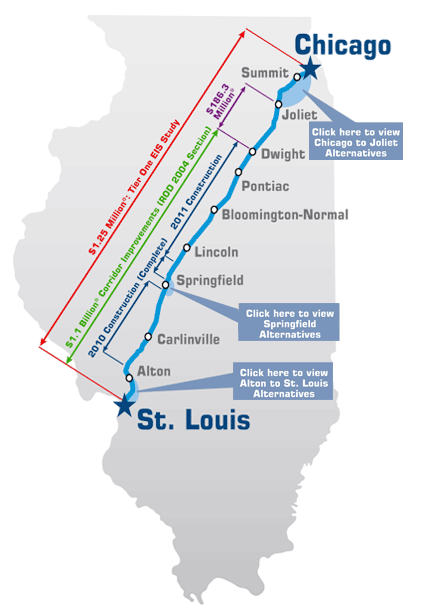Intercity rail dreams in the Midwest have certainly seen their share of setbacks -- with federal funds being returned in Ohio, Wisconsin and, more recently, Michigan. But all is far from lost.

Yesterday, U.S. DOT announced a $186 million grant to Illinois DOT to upgrade the line between Chicago and Joilet -- about 40 miles southwest of Chicago -- one of the final segments to be built in the 284-mile Chicago to St. Louis line.
The project will allow trains to travel up to 110 miles per hour and, when completed, will save travelers about an hour, U.S. DOT reports. That's good news for the about 35 million people travel the corridor annually. According to the Illinois Department of Transportation, about 90 percent of those trips end at either terminal: St. Louis or Chicago.
Michigan, Minnesota and Indiana are all in the midst of upgrading intercity rail lines as well, although it might not be accurate to describe many of these projects as true high-speed rail. (True HSR runs at an average speed of 110 miles per hour, as opposed to a maximum of 110.)
Michigan has funds for line upgrades between Kalamazoo and Dearborn -- just outside Detroit. Meanwhile, Amtrak will be completing the remainder of the Detroit-Chicago link west of Kalamazoo to Chicago. The line will top out at 110 mph, said Richard Harnish, Executive Director of Midwest High Speed Rail Alliance.
In addition,  Minnesota has begun an environmental review process to upgrade and modernize rail connections between St. Paul and Chicago. The state is also beginning the environmental review process on a true HSR link between the Twin Cities and Rochester, Minnesota, where the Mayo Clinic is located.
Minnesota has begun an environmental review process to upgrade and modernize rail connections between St. Paul and Chicago. The state is also beginning the environmental review process on a true HSR link between the Twin Cities and Rochester, Minnesota, where the Mayo Clinic is located.
Indiana, meanwhile, is taking responsibility for the portion of the St. Louis--Chicago line that lies between its borders.
Harnish said the country has slowly been moving toward modern rail transportation for decades -- in fits and starts. Despite vested interests that seek to maintain the status quo, he is optimistic.
"I truly believe that there is a strong desire at the ground level to have better ways to travel and that there is a desire to have high-quality passenger trains," he said. "If we can organize that base, we will get policies changed in DC."





